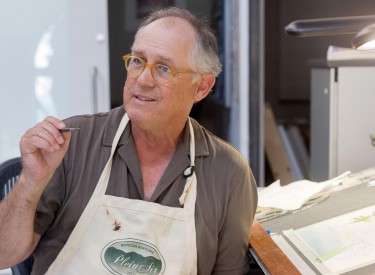By: Jen Ladd
Few people don a smock after elementary school, let alone as adults in the office. Stewart White is an exception. The Design Collective architectural illustrator spends his workdays painting masterful renderings that prompt even the least complimentary panelist on the city’s architectural review panel to praise his technique.
The Baltimore design firm refers to White as a secret weapon, capable of producing architectural artwork at a moment’s notice. Rather than map out each angle meticulously and mathematically — as a computer-designed rendering requires — White can conjure a building’s mass and material with watercolor in as little as an afternoon, if need be. He typically paints two renderings per project, but the industry veteran has a cabinet overflowing with sketches in various mediums from seven years’ work with Design Collective.
The Business Journal spoke with White about his work and his process — and we were treated to a short demonstration of his watercolor work.
Are there a lot of people who do what you do these days? Not really. I think that the last recession kind of thinned the herd out. A lot of people just took up other things. Up to that time a lot of computer-generated stuff and outsourcing in India and China really took a big clearing out of people [who] just couldn’t compete at those prices. Now the Chinese prices are [going up], the U.S. prices are a little more competitive. But the main point of a lot of the illustration is to describe what the architects are doing. Another part of it is getting the emotional part of it going to get interested in it. And that was where you throw in a lot of tricks, a lot of attractive entourage, cars, things like that. It’s all this sort of sales aspect of it.
What are you trying to sell? Well, what I’m leading up to — what we do here at Design Collective is, yes, we’re in the process of designing a building, and not everything’s worked out, but it’s time to show it to the client, time to get things moving, time to get neighborhoods involved. So by rendering in-house, it’s kind of giving it that quality of, ‘Yeah, this looks like it actually fits in the neighborhood, it’s something I can relate to, the materials are warm.’ That kind of a thing. And I think watercolor is just one of those great mediums for doing it, because your eyes are attracted to the material of the paint, and the eyes sort of lead the rest of the mind and the heart behind it. It’s not — what was it somebody used to say about perspective? ‘It can tell the truth real well, but it lies just as well.’
Is watercolor a common medium for rendering? It has been. Mostly it was airbrushed with inks. For a lot of sort of office-park-type projects, most of the renderers, they were rendering factories. They’d use tempered pen and wash paints, because you can keep editing and throwing things out. And I haven’t seen many of those in a long time.
When you need to edit a watercolor rendering, do you have to start from scratch? Not at all, I think that’s where the digital and this analog rendering work hand in hand. Because if it’s just a small change — add a floor, something like that — I can paint that, drop it into the original file after it’s scanned in, and I can adjust materials, color of the glass, all that’s done digitally in image-editing software like Photoshop. That would have, in the past, required redoing it, but now it’s kind of a breeze.
How many renderings do you usually paint for one project? Usually there’s probably no more than two, because in a lot of our projects there might be a retail component, and we want to play that up, and then we might shift it over to where it’s residential entry or if there’s an office in a mixed-use project and we want to see what that lobby area is, so to doing it in pen might be a scale issue.
How much time does it take? Depends on the deadline. If we need it this afternoon, then it gets done in one afternoon. I’ve been doing this 20 years. I think I can cover 80 percent of the rendering in the first half-hour with sky and streets and everything else, and then it’s a matter of doing all the glazing and then doing all the metal. And then it’s sort of finishing up with the brick. And then we scan it and spend about an hour with airbrush tools in Photoshop just to give it that little ping.
How did you get into this? I was studying at Berkeley, had an art major, and I wanted to get into architecture. My brother’s an architect, my dad was a builder. ... Oddly enough it was a girlfriend’s brother-in-law was an architect, he was doing these really nice estates in Beverly Hills. He just needed someone to put Rolls Royces and BMWs in front of Tudor-style mansions. And I was just working with pen and ink and knew nothing about setting up a perspective, so my first drawings were — I mean he just gave me the drawings and said, ‘Try to imagine what this would look like’. And then I figured out you got to learn how to project it. That was a painful experience, but after I figured it out, it was really fun.
http://www.bizjournals.com/baltimore/print-edition/2015/08/21/how-i-bring-buildings-to-life-with-watercolor.html
